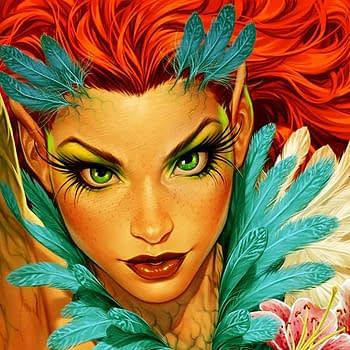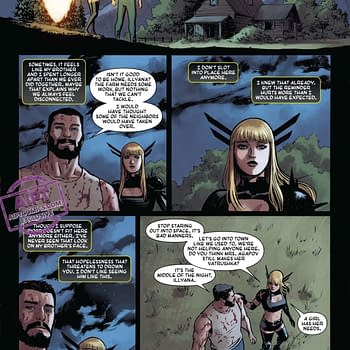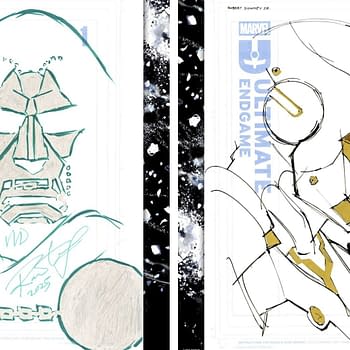Posted in: Comics, Recent Updates | Tagged: alien, Andy Khouri, blade runner, Brett Weldele, brian wood, Channel Zero, Comics, Cuberpunk, Dan O'Bannon, David Carrier, entertainment, gary panter, graphic novels, Gyan Prakah, Jon Savage, Matthew Shaer, neuromancer, philip k dick, ridley scott, robert crumb, The Couriers, The Fifth Element, underground comix
Cyberpunk's Influence On Brian Wood's Channel Zero And The Couriers
By Bart Bishop
Graphic novelist Brian Wood's Channel Zero (2000) and The Couriers (2003) fuse baroque sequential art with misanthropic prose. Wood's surface influences of "punk rock" and cyberpunk are demonstrated in his aesthetic choices, utilizing the zine methodologies of early "underground" comic books and punk magazines and taking clear visual inspiration from the works of French comics artist Mœbius. This is especially true of Mœbius's "The Long Tomorrow" (1975), a short story that had semiotic influence on the film Blade Runner (1982) and by extension the populist perception of dystopia and the cyberpunk genre as a whole.
Channel Zero is presciently au courant, a highly political anticipation of the Patriot Act and predominance of the media in the 21st century. The Couriers, however, is a decidedly different kind of ethos. Whereas Channel Zero is cerebral, meditating on the power of tropes and manipulation of digital information, The Couriers is a mimetic adrenaline rush of high-octane action, harkening back to Old West shootouts and 1970s-style car chases. Although Channel Zero and The Couriers share a fictional universe (along with Couscous Express (2001), Wood's earlier works are connected by cameo appearances and off-hand references), the latter lacks the political slant of the former. There is, however, a strong theme of free will and the democratization of information in both books that has continued through his career.
Channel Zero's main character, Jennie 2.5, is a "console cowboy", a hacker, in the tradition of Neuromancer's Case. She also fights against a powerful and faceless figure of authority, in this case a malevolent United States government (personified by a man shrouded in shadows in an empty room) that has passed The Clean Act, the result being "ultra-paranoid Christian extremist parents" taking control of all media and censoring any free expression (Wood 1). Channel Zero, however, settles for skeptical obfuscation. Jennie 2.5, by the end of Channel Zero, has accepted that she is "too old and too well known…to fight both the government and [her] own horribly twisted public image" (Wood 143). She leaves the task to the next generation, "the young and stupid ones," without a word of guidance or helping hand (143). The self-disgust is obvious on Wood's part, as Jennie 2.5's pedantic tone disguises hollow submission.
The Couriers, by comparison, adopts a more self-mocking tone. Moustafa and Special are rollerblading couriers, but "they won't take every job offered them," never anything that violates their broad personal ethics (Wood and G. 27). When they are tasked with transporting a young Chinese girl to her family, they find themselves caught up in direct conflict with The General, a madman who is after the little girl. This informs the running theme of personal choice. At the core of Moustafa and Special's ethics is an edict to never usurp free will. Any figure of authority, most prominently The General, is mocked as antiquated or inadequate, with even his own men musing, "Central command was right. He has gone mad" (60). In fact, the authority in this near future is so ineffective as to be non-existent, with police and government only mentioned in passing but never seen.
To understand Wood's ideology, it is important to define the punk dogma that dominates his work. Music journalist Jon Savage, in his book Teenage: The Creation of Youth Culture (2008), describes the sub-genre of rock music that developed in the mid-1970s as having an abundance of precedents and influences, and it can be viewed as a confluence of almost every previous youth culture that existed in the West since World War II (xvi). Authenticity is the key aspect of the culture and though punk rock may lack coherent ideology, it is generally Leftist and concerned with individual freedoms and anti-authoritarianism. "No Future," a line from the Sex Pistols' song "God Save The Queen", was a common slogan of the movement. It is no coincidence that the back cover of Channel Zero describes the book as "combining current events and no-future shock into a dark, paranoid, deep-ambient visual narrative." In the 1970s, punks had a philosophy based on a feeling of approaching the end of history and that everything has already been accomplished.
This vibe of counter-culture fetishism and youthful anger, along with the rhythm and pacing of a garage band, permeates the aesthetic and attitude of Channel Zero and The Couriers. Even Wood, in a 2006 interview with Matthew Shaer of The Village Voice, describes Channel Zero as '"an art student's rant'" and a "'zine where everybody talks about what pisses them off".' Most of Wood's creator-owned books are in black and white, with hyper-realistic cartoonish styles. This is exemplified by exaggerated, lanky bodies and sketchy line work, with thick jagged ink. Although Wood set the standard by penciling Channel Zero, later collaborators such as Brett Weldele on Couscous Express and Rob G. on The Couriers incorporated Wood's style into their own, maintaining a thematic, but not tonal, consistency across those works.
Andy Khouri of Comics Alliance sums up Wood's style in a 2011 interview when he says it "represents an arduous, expressly DIY method of comic book-making that new technology has dramatically changed […] [and is] the culmination of all that graphic design and photography and zine-making and New York street art/culture-inspired material" that Wood experienced in college. In that interview, Wood goes on to say:
I love Channel Zero to death, but it was not an attempt to tell a story, at least not anything approaching a traditional one. I started it as an Illustration major in art school and that was my focus: the art. I had too many ideas, a lot of passion, a lot of anger (especially at local politics), and that freedom one has in an art school environment to just go off. I was also learning the tools and techniques of comics entirely on my own, since, unlike the nearby School Of Visual Arts which has a comics-creating program, my school (Parsons) had nothing. So I was really figuring it all out myself. I was shouting, essentially, with Channel Zero.
Wood used the craft of the underground and the activist. In the "Creator's Notes" of Channel Zero, he describes how the book was "produced with support from Utrecht 2-Ply Bristol (vellum), #3 and #4 white sable brushes, and Chinese calligraphy ink," with the tools of the zine (Wood "Creator's Notes"). Zines, most commonly a small circulation publication of original or appropriated texts and images, were greatly influential on this look. Zines allow anyone to make a poster or flyer cheap and easy with a photocopier. Wood was doing this all from scratch, outside the system, and he was very aware of his image. This fostered association with the punk aesthetic distanced Wood from the status quo. He positioned himself as outside the comic mainstream, taking inspiration as well from the Underground Comixs of the 1960s and 1970s.
The Comix movement of 1968-1975 involved small press or self-published comic books that were often socially relevant or satirical in nature. They differed, according to Todd Hignite in his In the Studio: Visits with Contemporary Cartoonists (2006), from mainstream comics in depicting content forbidden by the Comics Code Authority at the time including explicit drug use, sexuality, and violence (6). Most notable is Robert Crumb for his work on Fritz the Cat, which was popular in the hippie counterculture scene, and Gary Panter who defined the grungy style of the Los Angeles punk scene with his drawings for the punk fanzine Slash Magazine (62). Channel Zero, also published without the Comics Code Authority, creates a hypothetical scenario in which the material within, what Jennie 2.5 produces, is forbidden. The brilliance of Channel Zero is that, through its aesthetic and attitude, it makes the audience feel as if they are reading a banned book.
As for the Mœbius connection, the science fiction landscape of the last 40 years has been forever altered by the French artist. Mœbius's most famous work "The Long Tomorrow" was published in the science fiction and horror anthology magazine Métal Hurlant (1975-1987), "itself inspired," says Charles Hatfield in Alternative Comics: An Emerging Literature (2005) "by the free-spiritedness of the American underground and known for extravagant, visionary artwork" (26). "The Long Tomorrow" was written by Dan O'Bannon, a screenwriter for Ridley Scott's Alien (1978), itself regarded for its worn down, lived-in future environment. The short story's narrative, set in the far future, parodies American film noir, a term for crime dramas from the 1940s and 1950s that Gyan Prakah, in the introduction to Noir Urbanisms: Dystopic Images of the Modern City (2010), says "projected a mood of urban anxiety and nihilism" (7). This synthesis of genres, science fiction and film noir, laid the groundwork for Blade Runner and cyberpunk.
As William Gibson stated in the introduction to the graphic novel adaptation of Neuromancer (1989): 'So it's entirely fair to say […] that the way Neuromancer-the-novel "looks" was influenced in large part by some of the artwork I saw in 'Heavy Metal'. I assume that this must also be true of […] Ridley Scott's "Blade Runner", and all other artifacts of the style sometimes dubbed "cyberpunk."' In a 1992 issue of the magazine Details, Gibson extrapolated the influence Blade Runner had on him: 'About ten minutes into Blade Runner, I reeled out of the theater in complete despair over its visual brilliance and its similarity to the "look" of Neuromancer'.
Blade Runner, the story of a burned out detective in a future Los Angeles who hunts genetically engineered humans, is based on Philip K. Dick's detective thriller Do Androids Dream of Electric Sheep? (1968). Today it is considered a classic, cited on several professional lists including Sight & Sound's 2012 "Critics top 250 films" and "Directors top 250 films", and is now the standard template for fictional dystopic futures. Although the book was published prior to "The Long Tomorrow", the movie owes a visual debenture to Mœbius, betoken in that same issue of Details in a conversation between Gibson and Scott: "we were both clear about our debt to the Métal Hurlant [the original Heavy Metal magazine] school of the '70s-Mœbius and the others" (ibid).
What is most evident about the sequential narrative of "The Long Tomorrow" is its bloated, busy decay. A hard-boiled detective diegesis, complete with rectangular captions containing sardonic narration, there are skyscrapers and neon signs ad infinitum. The imprint of "The Long Tomorrow" on Channel Zero is attested in the visual presentations of sprawling cityscapes, technological saturation, and impious voiceovers. Each page of Wood's first publication is, much like "The Long Tomorrow", sparse in panels, relying on "splash" pages, entire pages devoted to one image more often than not. Backgrounds are often left blank, but the foreground is dense in detail, inundated with flickering screens and tangled wires. Jennie 2.5's voiceover, although she is not a private investigator, is like a futuristic version of Raymond Chandler's Philip Marlowe parataxis: "Inside one of these uber-geek hangouts, surrounded by greed and way too much fucking attitude, this is where it started" (Wood 5).
Similarly, The Couriers shares vast vistas of urban atrophy, but the clear indicator of the Mœbius influence on artist Rob G. is his handling of kinetic action sequences. The opening sequence, set in Chinatown, is more than reminiscent of the car chase and gun fight that takes place halfway through "The Long Tomorrow". Both artists rely on what David Carrier, in his The Aesthetics of Comics (2000), calls moving the depicted scene: "Two images already constitute a narrative, for their meaning is inscribed in the succession. In understanding how these pictures are connected, we imagine some appropriate action" (51). This presupposes the reader's engagement in filling in the blanks. While Mœbius was paving a new way, Rob G.'s art purposefully evokes the kind of modern "widescreen" action cinema that had become so prominent, such as The Fifth Element (1997), on which Mœbius was the Art Director.
Regardless of whether Brian Wood or Rob G. ever read anything by Mœbius or saw Blade Runner, the influence is unmistakable. This can be attributed to the suffusion of both on western popular culture, especially in science fiction. The standard visualization of a dystopic or post-apocalyptic future in fiction today can, therefore, be tied back to the clear progression from zines and comix to Mœbius, Mœbius to Blade Runner, and Blade Runner to cyberpunk, which in itself can be seen in Brian Wood's work.
Editor and teacher by day, comic book enthusiast by night, Bart Bishop has a background in journalism and is not afraid to use it. His first loves were movies and comic books, and although he grew up a Marvel Zombie he's been known to read another company or two. Married and with a kid on the way, he sure hopes this whole writing thing makes him independently wealthy some day. Bart can be reached at bishop@mcwoodpub.com.



















